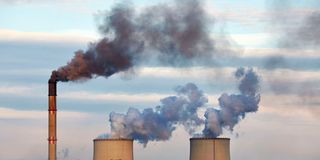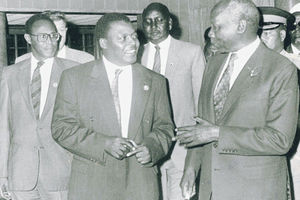
A fossil fuel power station. Five industries channelling most of the negative financial flows are oil and gas, construction, electric utilities, real estate and food and tobacco.
I stayed up way past my usual bed time on Monday to listen to the speech by United States President Donald Trump during his inauguration. Here are some of the quotable quotes and one-liners I picked up: “Drill baby drill”. “Fill strategic reserves to the top”.
Trump also issued notice that he will be withdrawing the US from the Paris Climate Accord and pooh pooed the widely acclaimed promise of green energy; especially wind farms and electric vehicles.
I think that there are big lessons for us in terms of our own policy choices and priorities in the energy sector.
In my view, our best chance at making electricity prices affordable to the people and ensuring security of supply is increased investment in locally produced power, especially in coal and gas.
Where the electricity consumer sector is today, Kenya cannot afford to uncritically swallow the climate change hysteria root and branch.
Way back, in September 2013, the government put out a request for proposals for the development of a 960MW coal fired plant in Lamu by private investors. That project attracted the interest of very big names in the international space, including Tata of India; Mitsui, Toyota Tshusho and Marubeni of Japan; and Synohydro and Shangai Electric of China.
That project could not see the light of day partly because of stiff opposition by environment groups and international development finance institution that were against it mainly on the grounds of climate change concerns.
Several years ago, we discovered massive coal deposits within the Mui basin of Kitui. The government ended up giving the licence to briefcase entities without capacity to roll out the project. It seems that their intention was just to hold on to the licence and later firm it out or flip it to third parties at a profit.
Today, you will not hear the government talking about its plans to exploit this critical resource in Kitui.
The electricity consumers and heavy industries in this country are paying inordinately high prices because of the cost of imported heavy fuel oil, which we purchase in foreign exchange. To see my point, just track movements and changes in the line item “forex adjustment cost” in your electricity bill and you will appreciate the gravity of the suffering that consumers endure as a result of the weak Kenya shilling.
The depreciation of our currency hits the electricity consumer in two ways. First, is what is known in jargon as realised forex losses—the losses that Kenya Power suffers when it has made foreign currency payments for actual foreign currency denominated obligations such as power purchase costs, loans and interest on government-guaranteed foreign loans, and fuel from power plants that use imported heavy fuel oil.
These costs are passed on to the consumer through the monthly forex adjustment costs using the Central Bank of Kenya mean exchange rate.
Second, is what is called in jargon unrealised forex losses. These losses are not recovered from the customer until the actual payments are made. They refer to book losses that Kenya Power suffers when it has to restate its loans and other liabilities denominated in foreign currencies in Kenya shillings, the reporting currency of its financial statements.
I ask: how can we free the electricity consumer from the tyranny of these fuel generators and from the so-called independent power producers who have to be paid in US dollars? Do we have a solution? Of course we do.
Kenya and Tanzania must resist the temptation to blindly join the green power lobby by leaving their oil, gas and coal in the ground in exchange for pledges for meagre climate financing from the West.
It is important to note that the remarks by President Trump were happening against a backdrop of serious and urgent plans by Kenya and Tanzania to build a liquefied natural gas (LNG) pipeline to run from Dar es salaam to Mombasa.
The last time I checked, the State-owned power generator, Kenya Electricity Generating Company (KenGen), and the Kenya Ports Authority, had identified a suitable location for the building of both an LNG terminal and an LNG power plant in the Ndongo Kundu area in Mombasa.
Several years ago, Kenya—in anticipation of the proposed LNG pipeline from Dar es Salaam to Mombasa—came up with laws and regulations that oblige fuel oil power stations to convert from expensive fuel to cheaper natural gas as soon as the natural gas is available and is within reach.
If the project takes off, it will change the landscape and math of power generation because, within the Mombasa region alone, Kenya has a total of five power stations that will be obliged to do a fuel-for- natural gas swap when the Dar es salaam to Mombasa pipeline is completed.
My parting shot to Kenya and Tanzania: “Drill baby drill!”













